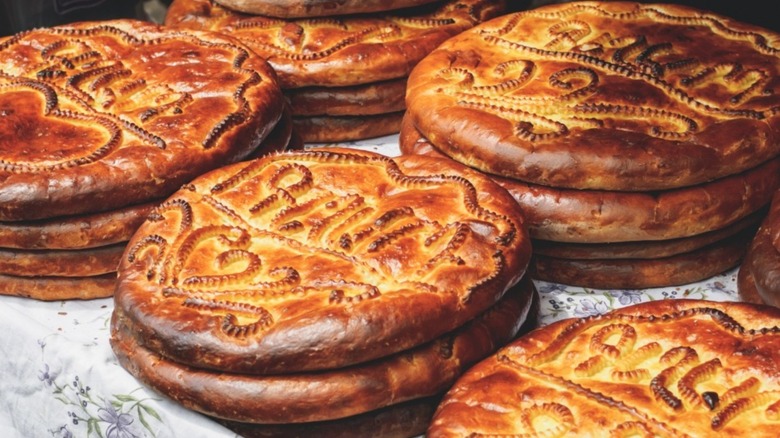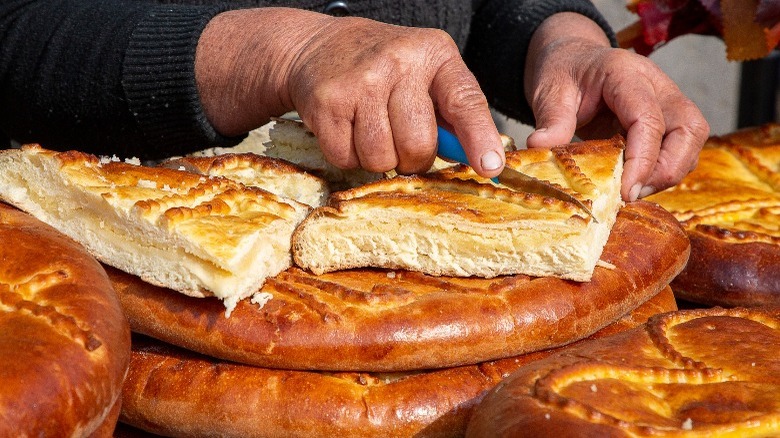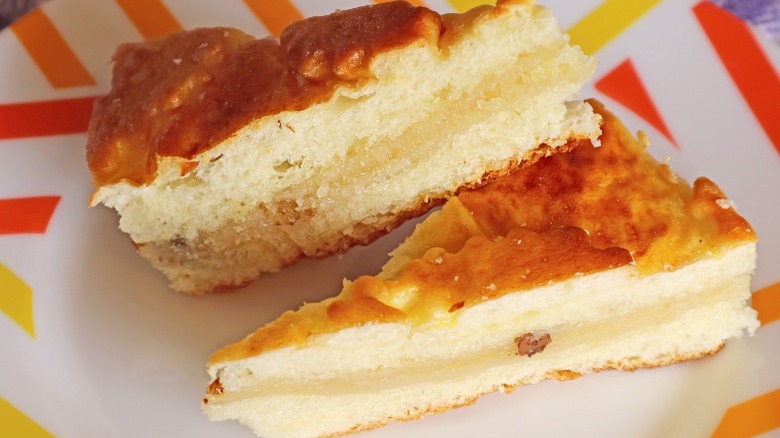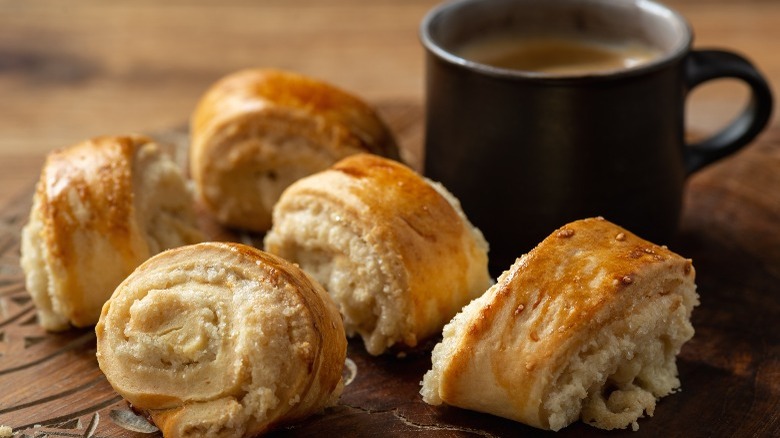Gata: The Buttery Armenian Cake That Pairs Perfectly With Coffee
There's something about mildly sweet and buttery treats that just works so well with a hot cup of coffee or tea. Cinnamon coffee cake, a flaky croissant, a simple cheese danish, Scotch shortbread, or even a slice of classic pound cake can be a not-too-sweet but still comforting reminder of home. It's the heady breadiness of it all that makes these treats such standouts. Texture (crumb-versus-flake, crackling-crisp, or pillowy-soft) and density take center stage, mingling with subtly sweet, butter-wrapped flavors that linger on the tongue in such a perfectly satisfying balance that plays so well with the nutty, aromatic acidity of your favorite cup of Joe.
A treat like this is always welcome for breakfast or dessert, tea time, or coffee break — even special occasions. Gata is just such a treat. And pairing it with a good cup of coffee simply feels so right.
What is gata?
Gata (also called "katah," "kata," or "gatah") is an Armenian sweet bread, the texture of which varies depending on what region your recipe comes from (via iArmenia). It has been described as everything from croissant-like to more cake-like, akin to Danish pastry, and even rugelach (a traditional Jewish cookie made of pastry dough).
There are many regional and familial variations of this popular Armenian treat. This is due at least in part to its popularity and longevity.
There are the more traditional rounds, baked golden to amber in color, decorated with symbols and marks, which look as if their texture might be like that of a savory calzone or cornish pasty. But don't be fooled — inside this decorated round, lives the fluffy-yeasted heart of a lightly sweetened cake-bread, whose texture is more akin to a Danish pastry.
Then, there is the smaller, individual-sized "laminated" style Gata made with baking soda or powder. These simple, hand-held pastries often resemble a large rugelach but can also come in small rounds containing buttery, flaky layers, similar to a croissant.
The thing most of these recipes have in common is their filling — khoriz. A crumbly mixture of flour, butter, yogurt, and sugar (and sometimes a bit of cognac or rum, says Snack Stack), khoriz is similar to the crumble you'll find sprinkled atop Danish pastries (wienerbrød in Denmark) or streusel. In some areas, the khoriz has walnuts added to the filling. This version is often found in southern Armenia (near Iran) and is called "nazook" by Iranian Armenians (via Mission Food Adventure).
History of gata
Gata is special to Armenians. It is entwined in the fabric of the culture and in their daily lives. It's served on most reverential occasions such as the Christian holiday of Candlemas, as well as an everyday treat.
And nowhere is gata more sacred than in the village called Geghard, where the roots of this ancient pastry's popularity are tied to the spread of Christianity and the creation of the Monastery of Geghard. There is something special about gata from Geghard, Australia's Special Broadcasting Service notes, "Although gata is made throughout Armenia, the gata that the locals in Geghard make tastes different to gata from around the country. They use milk from their farms and put their own unique spirit into it." Atlas Obscura notes that to this day, "You'll notice elderly ladies clustered around roadside stalls leading to the site, selling round gata cakes inscribed with patterns and intricate Armenian script."
But the tradition of adorning this sweet bread began long before Christendom. In fact, according to Hamlet Martirosyan, author of the paper, "A Neolithic Origin of the Cake 'Gata'" for the Centre for Research on Ancient Civilizations, the first mention of gata is in an ancient medieval fable, though there's archaeological evidence to suggest the cake itself predates that first record by centuries. Though the ornamentation on gata today is seen as just a decorative pattern, Martirosyan explains the evidence suggests that these cakes were originally embossed by stamps, representing different deities, and used as ritual bread sacrificed to the gods.
How to make gata
Every autumn, the Armenian village of Khachik welcomes visitors from all over to take part in the Gata Festival, where villagers and tourists alike celebrate all things gata and take part in assembling and eating the world's largest gata (via My Armenia).
If you can't make it to the festivities — don't worry, you can make this tasty coffee companion at home. You'll need to make a few key decisions in order to choose and settle on a recipe that's right for you, like: Which size gata? Do you want one large round to serve everyone or several smaller, individual pieces? Which texture do you prefer (fluffy, dense, or flaky layers)? Will you be adding cognac or rum to your khoriz? How about walnuts? Once you've found a recipe that fits your choices, the instructions are fairly simple: mix the ingredients together (flour, butter, yogurt, or sour cream, and one of these — yeast, baking soda, or baking powder). When the dough has risen and/or chilled, roll it out and sprinkle on a single layer of khoriz (flour, sugar, butter, with or without cognac, rum, or walnuts). Fold and seal the dough, locking the filling into place, before scoring or decorating it. Brush with egg wash to give your gata its signature sheen. Pop it in the oven and watch it puff up and turn golden brown.
While it's baking, be sure to brew up a cup of your favorite Joe and get ready to enjoy a pairing so perfect it's lasted for centuries.



